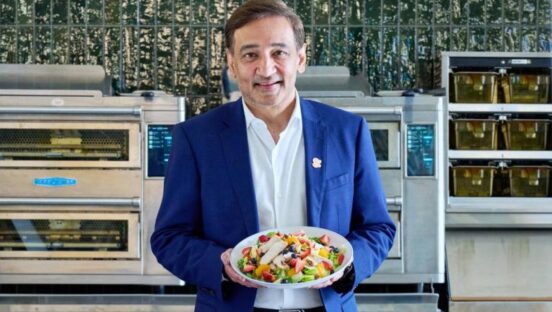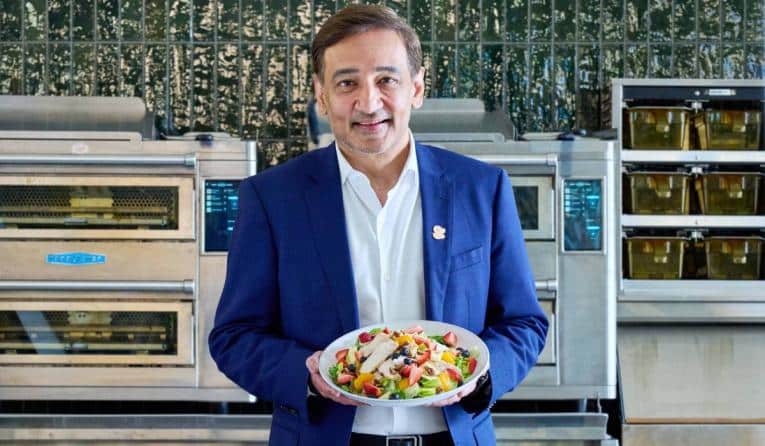Panera Chairman Niren Chaudhary doesn’t mince words when it comes to sustainability.
The restaurant industry veteran calls climate change one of the biggest challenges humanity faces, and he’s far from the only one. Earlier this year, United Nations scientists said the planet is warming at such a rapid rate that it may cause irreversible harm. The group referred to it as a “final warning.” Meanwhile, greenhouse gases are at an all-time high, ocean levels are rising, deserts are expanding, and species face extinction.
If food isn’t at the center, it’s close. U.S. restaurants accumulate 22 billion to 33 billion pounds of waste each year, according to FoodPrint, a report aiming to increase awareness of key environmental issues. Roughly 4 to 10 percent of purchased food is wasted before reaching customers. Food systems contribute almost 30 percent of greenhouse gas emissions. But that’s far from the worst part of it.
“We are already late to the party,” Chaudhary says. “It’s an imperative that anybody in the food retail industry must do more to make a contribution.”
Chaudhary doesn’t throw out that call to action lightly. The warning comes from a place of authority and leadership. He’s been with Panera since May 2019, but the fast casual’s penchant for sustainability dates back to its origin when founder Ron Shaich recognized customers sought more than processed meals. He had the vision of serving food that was both craveable and healthy, without artificial colors, flavors, sweeteners, and preservatives.
In 2022, Worth Magazine listed Panera as one of its Top 10 Most Sustainable Companies. The chain was also on Inc. Magazine’s 20 Most Purpose-Driven Brands of 2022, alongside the likes of Google, Clorox, Patagonia, and REI. Panera was the only restaurant on the list.
The reason why Chaudhary is inspired to work at Panera is that there’s a strong convergence of what appeals to him personally and what the brand stands for. The chain’s purpose is to make the world healthier and happier, and it looks to achieve this objective through an impact agenda that covers food beliefs, community, and a commitment to inclusivity.
The chairman believes his C-suite position is a privilege and that leaders must be force multipliers of good. Sustainability is a moral imperative, nothing less. To Chaudhary, everyone needs to do more to help the world. Even Panera—for all it’s done in the past few decades—has room to be better.
“I think that captures everything,” Chaudhary says. “That was the notion with which the founder created the brand many years ago. As we move forward, we have carried the torch with a deep sense of responsibility of wanting to continue to elevate good eating.
“Having a broader impact as a leader at this time in the economy, in the world, I think is massively important.”
Keep it Clean
Sara Burnett, who serves as Panera’s vice president of food beliefs, sustainability, and public relations, understands sustainability through several definitions.
The executive could give a technical, academic answer—which would likely be on par with her. But she simplifies it to how the fast casual can have a positive impact for people, planet, and communities in any decision it makes. Burnett emphasizes that sustainability is a much higher level than just a recyclable piece of packaging.
“That’s how we need to think about it and hold it if we really want to make long-term systemic change,” Burnett says.
Panera has a lot of milestones in this area. Burnett would know best since she’s been with the chain for 18 years. There’s a hallway in the company’s Boston office that showcases accomplishments, and the brand has a rather difficult time fitting everything up there. Some actually have to come down, and that brings Burnett great pride.
Among her nearly two decades of experience, several achievements stand out. The first came in the mid-2000s when Panera moved into the “raised without antibiotics” chicken market and served the product in its Strawberry Poppyseed Salad. It was placed on the menu because focus groups labeled it as the best-tasting chicken. At the time, this type of meat was a small market, so Panera had to build the supply chain. Throughout that process, the team discovered that it was not only the best-tasting chicken, but it also resulted in better animal care standards and had “a very dramatic” public health effect, Burnett says. To this day, the menu item is a fan favorite and the top-selling salad. In fact, now all chicken, turkey, sausage, and ham used on the menu are raised without antibiotics.
In 2016, Panera committed to better welfare standards for broiler chickens. The chain works with animal welfare experts, growers, suppliers, competitors, and other market participants to identify cost-effective solutions. In a few years, it wants to use new broiler breeds recognized as having higher welfare outcomes, provide birds more space, offer improved environments (better litter, lighting, and enrichment), and ensure birds are rendered unconscious using multi-step controlled atmospheric stunning.
In June 2021, Panera completed its transition to receiving 100 percent of its primary egg supply from cage-free sources. Primary egg supply accounts for about 71 percent of the chain’s total egg sourcing; the plan is to reach 100 percent cage-free eggs across all products by the end of 2025.
“I think that’s when sustainability really pays off—when you recognize you’re delivering for everyone in a positive way,” Burnett says. “I’m very proud of that work, and Panera continues that today. And now in many ways, raised without antibiotics has become more of an industry standard, and especially in retail. I’d like to attribute that to the fact that we pushed, we grew the supply chain, we advocated along with many others.”
Burnett describes Panera’s commitment to clean ingredients as progressive. In 2010, the company became the first national chain to post caloric information on menu boards. A few years later, the chain announced a new food policy aimed at removing artificial additives from the menu in two years. In that time span, the chain reviewed more than 450 ingredients, partnered with more than 300 food vendors, and reformulated 122 ingredients. Burnett says it was an “astronomical feat,” but that Panera pushed through because everyone wanted the food to be nothing less than what they would share with their own families.
Then in October 2020—during the thick of the pandemic nonetheless—Panera revealed that it was partnering with the World Resources Institute (WRI) to label climate-friendly “Cool Food Meals” on its menu. It was the first national restaurant to do so. Similar to how nutritionists recommend a certain number of calories per day, the WRI has a maximum recommended daily carbon footprint for a diet, which is 38 percent smaller than average. The organization’s research shows that this type of diet is necessary to mitigate the worst impacts of climate change by 2030. According to the WRI, a breakfast’s carbon footprint can’t be more than 20 percent of the daily total; for lunch and dinner individually, it’s no more than 30 percent. The other 20 percent is for drinks and snacks.
“People who are environmentally conscious and want to make an appropriate choice, have the convenience of coming into Panera, and through their choice of where they eat and what they eat, they can impact climate,” Chaudhary says.
“… I certainly hope that the industry will also embrace the transparency and the carbon footprint just like they did the caloric value many years back so that it becomes a broader standard and it makes it easy for consumers to be more climate-conscious in the way in which they make their food choices,” he adds.
Panera’s Cool Food Meals—which covers 57 percent of entrées—have a low impact on climate and help guests remain below their carbon limit. Some examples include the Asian Sesame Salad, Chipotle Chicken Avocado Melt Sandwich, Fuji Apple Salad with Chicken, Green Goddess Caprese Melt on Baguette Sandwich, and Steel Cut Oatmeal with Strawberries & Pecans.
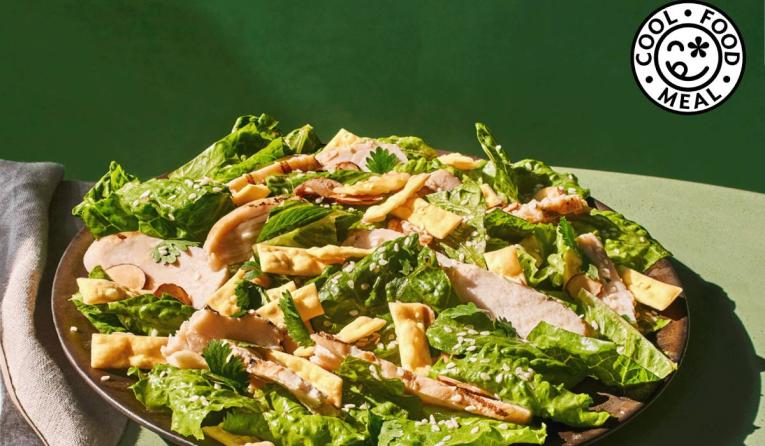
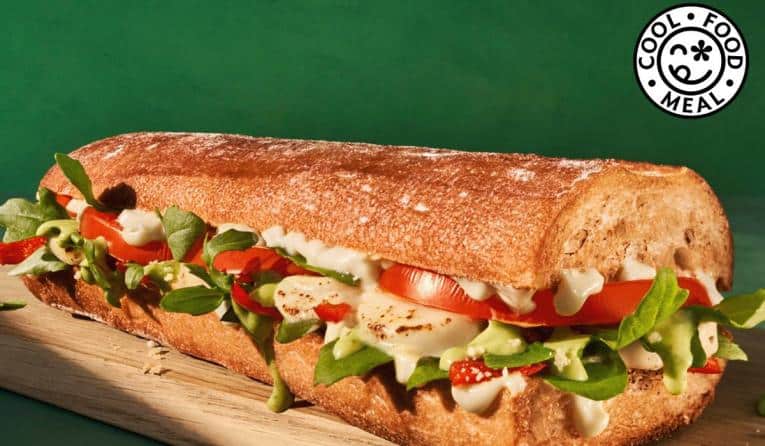
The company acknowledges that plant-based foods have a lower impact on the environment, but it reminds customers that they don’t have to be vegan or vegetarian to limit their carbon footprint. If each year, every person in the U.S. ate 10 Chipotle Chicken Avocado Melt sandwiches with chips instead of 10 quarter-pound burgers with fries, it would reduce emissions by 77 million metric tons of carbon dioxide equivalent, according to Panera. That’s equal to removing more than 16 million cars off the road in a year.
“I believe strongly that providing information and nudging guests to decisions that align with their core values but are also better for the planet can be incredibly impactful,” Burnett says. “We need to not only work on the supply side and the work that restaurants and our partners do, but there also needs to be some work on the demand side. And so we want to make sure that we’re being able to influence both.”
The Climate Challenge
For all the sustainable actions Panera has taken over the years, none may be more aggressive than its goal to be climate positive by 2050. That means the fast casual wants to take away more carbon from the environment than it emits.
The company said reaching this objective equates to removing roughly 2.4 million metric tons of carbon dioxide equivalents each year compared to its 2019 greenhouse gas baseline. For perspective, that’s the same as the amount of carbon sequestered by 2.96 million acres of forest per year, an area 14 times the size of New York City. This is a plan that touches the sustainability team, as well as culinary, supply chain, human resources, and other departments.
“When we think about our bold climate goal of becoming climate positive by 2050, while, yes that’s a lot of years away, there’s a lot of work to be done,” Burnett says. “So when you think about our carbon footprint, over 90 percent of it is in our supply chain and value chain. So a lot of the work that we’re doing over the years ahead is working with our partners and working on agricultural practices in the field to distribution networks and how to shorten them.”
The brand has a host of projects planned, but Burnett says the number one challenge for any sustainability professional is breaking everything into parts and not “trying to boil the ocean.”
Panera is setting science-based targets, which Burnett says is the most credible way to measure and set a climate goal. These are things Panera wants to achieve in 10 years, but the company views climate change as too pressing of an issue to wait.
After the chain first released its climate-positive stance in October 2021, Chaudhary says the peer set agreed with the general intent that neutrality may not be enough. At the same time, they looked at 2050 and immediately asked, “So what are you going to do right here, right now in the near term?” It’s the right question, Chaudhary says. Here’s one answer: Panera has already realized greenhouse gas reductions by investing in more energy-efficient store designs, lighting, HVAC systems, and kitchen equipment. It also decreased fuel use by consolidating deliveries.
“I think there is more curiosity around, ‘OK, tell us specifically what you will do by when,’” the chairman says. “And realistically, I think people are able to wrap their heads around nearer-term milestones. What are you going to do by 2025? That’s pretty tangible. And then also as we move towards 2050, are you really walking the talk on things that you ought to be doing so that you’re constantly demonstrating through behaviors that this is a serious commitment?”
The chain formulated three specific short-term targets for 2025.
One of these goals centers around transitioning to 100 percent circular packaging. The chain opts for packaging made with recyclable, reusable, and compostable materials. Three years ago, the brand revamped packaging for most of its hot sandwiches, which involved eliminating individual boxes and using a compostable thermal wrap. The switch led to a 60 percent decrease in material use and a package that increased heat retention and portability.
Additionally, Panera moved from a tri-fold napkin to a bi-fold, which cut 30 percent of raw material needed, but kept functionality. The company lets customers help by providing an “opt-out” option for single-use cutlery in the mobile app, via kiosks, and through third-party delivery. For dine-in guests, Panera uses real plateware and silverware to reduce the use of single-use products.
Another short-term objective is to use renewable electricity for at least 50 percent of company-owned operations. When it comes to this goal specifically, Chaudhary says Panera is constrained by availability and capacity in the U.S., but it’s something the brand is working through.
The third pillar considers the menu. Panera wants to increase the percentage of Cool Food Meals to 60 percent of entrées.
“Those are the projects that we’re very much in the weeds on right now and working toward and making progress on each and every day,” Burnett says.
Chaudhary understands that setting a goal for 2050 comes with the understanding that future leadership will have to take up the mantle and continue what Panera started. But that’s the whole point of making the strategy public—so the company can stay accountable in the coming years. Plus, momentum around sustainability is only getting larger and more important. It’s too much for any significant leader to ignore, let alone Panera.
The chairman says the company doesn’t have all the answers, but it knows sustainability is the right problem to solve and that it has a major role.
“I feel very confident that the foundation of the brand and what makes the brand unique and distinctive is so closely tied to it being a good social steward,” Chaudhary says. “I’m quite confident that with these goals being publicly committed, that future leaders will also have a similar level of commitment to drive compliance.”
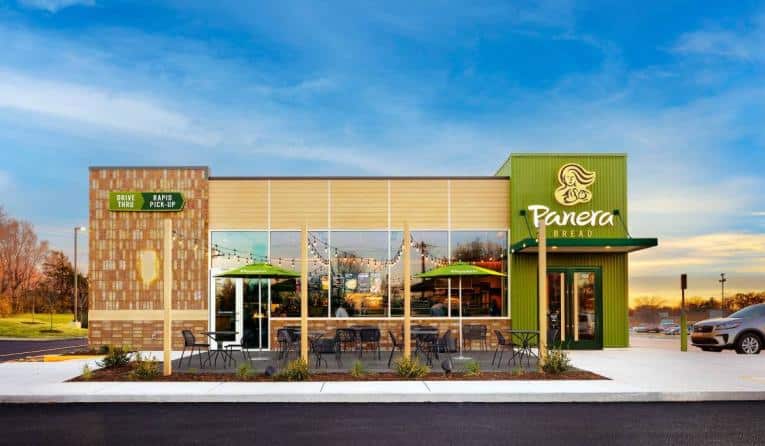
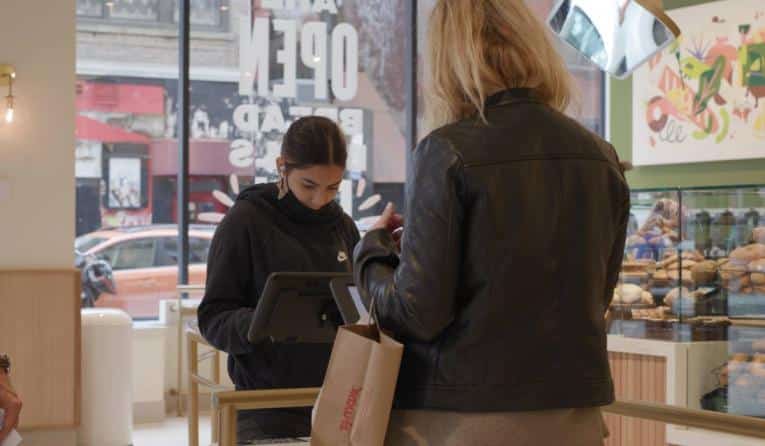
A Sustainable Reputation
As Panera looks across the global restaurant industry, especially post-pandemic, one unmistakable trend is that consumers care more about what they put into their bodies, Chaudhary says.
“I think we are obviously very credible on that dimension,” Chaudhary says. “Whenever we look at the reasons for which consumers choose us versus our competitors, overwhelmingly, the biggest response is that, ‘We think that Panera is best-in-class in serving food that we feel good about eating. We feel much better after we leave a Panera, having had a meal than we did when we went in because of the quality of the ingredients.’”
According to a 2022 Datassential keynote report, 90 percent of surveyed guests said sustainability, in general, matters to them. Fifty-seven percent said restaurant sustainability practices are “somewhat influencing” their decision to dine out. A little more than 21 percent said they would go out of their way to eat at a sustainable restaurant. Gen Z and millennials expressed a bigger connection to sustainability in comparison to baby boomers.
Chaudhary says it’s also an “established fact” that customers gravitate toward companies that have a clear impact agenda. So do investors and other associates—a majority want to do business with brands that seek a better world.
“There’s no question about it,” the chairman says. “So I do think that it not only is the right thing to do, but it also makes a tremendous amount of business sense.”
The pandemic certainly didn’t stop Panera’s mission. Not even the recent avian influenza outbreak.
“Some of the challenges actually presented us with an opportunity to strengthen and rethink how we were building our supply chain, which actually make us potentially stronger for the future for all those sustainability changes that we have coming in the future,” Burnett says. “Avian influenza destroyed for quite a long time, the egg market. Based off of our suppliers and the strength of our network, we’ve maintained our supply of cage-free eggs throughout the entire pandemic.”
Financially, being climate friendly brings its wins and losses, Burnett says. Panera chooses to think of the long-term return. Some things are investments for the future, like LED lighting, which might be costly upfront, but over time saves money spent on electricity. Systemwide, the company refers to this situation as the power of “and.” How can Panera do well in business and meet its climate goals?
Chaudhary says it’s a constant tightrope. The company will never stray from its food beliefs, but a business model can only move forward if there’s growth. As a result, Panera positions itself as a quality brand that believes in “offering more for a little bit more” concerning how its menu prices compare to quick-service competitors.
“We have to be profitable,” Chaudhary says. “Our investors have to get the appropriate return that they deserve. And if you’re doing that and our sustainable activities are also profitable, only then will they perpetuate. So at Panera, I think our commitment is very much a part of our value equation to our consumers and built into a business model.”
The chairman believes the company’s sustainable message—to customers, vendors, suppliers, and all stakeholders—can best be summarized by a proverb stating, “We do not inherit the Earth from our ancestors, we borrow it from our children.” Chaudhary finds it compelling as to what the world must do collectively.
That’s how Panera chooses to operate each minute, hour, and day.
“Food is one dimension of it, but also how we show up with our people, the culture that we build, how we embrace diversity, our commitment to giving, talent from underprivileged backgrounds, access to education, and our commitments to planet that we have formalized recently,” Chaudhary says. “That continues that whole theme of being very committed to having a broad impact agenda.
“And I think that is what then shows up as an enhanced reputation for the brand.”

